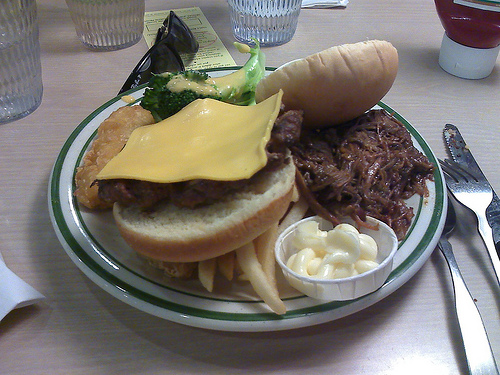How to Lose Weight and Gain Energy with a Food Combining Diet
There are countless diet programs, food tips and meal plans available. All have their own special advice; however, although they are telling you how much to eat and maybe when, not many talk about food combination, in other words, what types of foods you should or shouldn’t be eating together. When you think about it, it makes sense to consider proper food combining as the whole digestive process is a series of chemical reactions and chemical reactions vary according to the ingredients. So, depending on what we eat with what, we will be creating certain processes within our bodies which could be beneficial – or not. In fact, when we look at the chemistry of digestion, it makes sense that we would want to avoid eating certain different types of food together in one sitting and really consider food combination.
Let’s look at an example:
When we eat a carbohydrate (or starch) such as potatoes, our system starts to digest it right there in the mouth by means of an alkaline chemical called ptyalin. As a result of this, by the time carbohydrates reach the stomach they are already partially digested. However, when it comes to proteins (fish, meat etc.), our body only starts digesting them once they are in the stomach. Hydrochloric acid is used for this process. The digestion of carbohydrates requires alkaline conditions, whilst that of proteins requires acidic conditions. In the stomach the hydrochloric acid neutralizes the alkaline ptyalin, halting the digestion of the carbohydrates. The carbohydrates then sit in the stomach until the protein has been digested before they are then processed. In the meantime they ferment and this can result in indigestion, flatulence and a host of digestive disorders.
What is the answer to this particular problem? Do not combine proteins and carbohydrates in the same meal. This is one of the most basic “rules” of a food combining diet.

The Advantages of Food Combining
Food combining is basically a way of eating where one does not mix certain types of foods together at one meal. So, as we’ve seen, food combining will make digestion easier, but it has some further advantages:
The more complicated our meals, in other words, the more different types of foods we combine, the longer it takes for the food to be digested. Digestion is an active process which requires energy. If we can reduce the amount of time that it takes to digest our meals, we will free up that energy for other activities. By following food combination guidelines and eating more simple meals we can speed up the digestive process and have this extra energy available. So, food combining creates a link between diet and energy and is a way of increasing your energy levels. With this you can push your exercise plan.
Also, when we eat complicated meals, our bodies don’t absorb all of the nutrients from the food. By eating simple meals, our body can maximize nutrient uptake and we need to eat less for the same amount of nutrition. Eating less also leads to weight loss. You can always aim for a low calorie diet as well.
Furthermore, junk foods do not fit easily into the food combining guidelines, so, if you are strict about it, you will be eliminating them from your diet. This is another factor that may cause you to lose weight – not to mention the extra exercise. This is healthy weight loss.
A Basic Guide to Food Combining
There are a number of different schools of thought when it comes to food combining, so if you read further on the topic, don’t be surprised to find some other ideas and “rules”. The important thing is that, whatever plan you decide to try, you must to stick to it rigidly.
These are, however, the basic guidelines to follow:
- Never eat proteins and carbohydrates together. Proteins are foods that contain more than 15% protein (fish, meat, chicken, cheese, most nuts etc.) and carbohydrates are any foods that have over 20% carbohydrate (potatoes, grains, rice etc.) So, for example, no chicken and rice or, no cheese-sprinkled potatoes etc.
- Fats are not considered to be proteins so they can be consumed with either carbohydrates or proteins.
- Legumes (beans, lentils etc.) are considered to be carbohydrates as well as proteins; so, exclude them from your diet. If you want some proof of this food combining theory, then consider the following: What often happens when people eat baked beans? Well, this is the typical result of combining carbohydrates and proteins in a meal.
- Eat fruits by themselves. So, no fruit and yoghurt.
- Do not eat more than one protein in a meal; in other words, eat only eggs or only bacon and not bacon and eggs. The same applies for carbohydrates. So, choose either rice or potatoes, not both of them in the same meal.
- Proteins can only be eaten with vegetables and salad ingredients. Similarly, carbohydrates can only be mixed with vegetables and salad.
Now, it makes sense that you need to give your system some time in between meals before you eat something that is going to go against the food combining principles. In other words, you can’t have a chicken salad and then 15 minutes later a slice of bread. So, how long do you need to wait? Well:
- Once you have had a meal, wait 3 hours before eating anything. (You’ll find that a food combining diet helps you not to snack excessively.)
- Fruits can be eaten about 1 hour before meals as they digest relatively quickly.
Some other points that will always stand you in good stead:
- Stick to healthy foods (this will make following a food combining diet will be easier.)
- Plan your meals so that you have the ingredients available and aren’t tempted (or forced) to combine incorrect foods.
- Know how much you need to eat in order to last for 3 hours before the next meal.
You need to think carefully about what foods you are mixing. It can be relatively easy to slip up. These are some no-no’s:
- Coffee with milk can’t be drunk with biscuits (protein and carbohydrate).
- Cereal and milk will have to go. Protein and carbohydrate again. You may find that it is easier to start eliminating dairy products from your diet.
- Sandwiches are going to be difficult to rely on as a quick and easy meal as you are limited in choice of fillings. You can’t have cheese or chicken etc. (carbohydrates and proteins again.) You have to use something like avocado, salads etc.
- You’ll need to stop the fruit juice and soft drinks at meal times. This is a good opportunity to increase your water intake.
- Consider puddings, deserts and sweets carefully as these are often combinations of carbohydrates and proteins.
Concluding Comments
Switching to a food combining diet may seem like a mammoth undertaking, but, once you get into it, you’ll find it easy to sort out your daily eating plan. You can introduce the changes slowly over a few days if you are finding it difficult. Never get angry with yourself if you slip up – just ensure you get it right the next time you eat. As always, you must stick to the “rules”. Even just a small bite of protein with a carbohydrate will negate your efforts. It only needs that one little taste of chicken to start the protein reactions going in your stomach.
Try the diet out for at least two weeks and notice the changes. You should feel increased energy. You may find you are losing weight quite quickly and you could even find that some allergies or other ailments are relieved. It is well worth it.
- Eat Less by Changing Your Eating Behavior
Eating is part of survival and, as such, our body naturally lets us know when it requires nourishment; in turn, it responds when we have had sufficient to eat. However, more and more, external factors are also playing a part in when we start and stop - How to Lose Those Last Pounds
You can pick and choose from many a weight loss program out there and there are some very good ones. You can follow the best diets and follow all of the tips, but still struggle to lose weight;especially those last few pounds. What is it? ... - Milk - One Of the Bad Acne Foods
We don't often think of milk as being one of the foods to eliminate in order to improve acne; but it is. This article tells you why.
Image credit: VirtualErn









